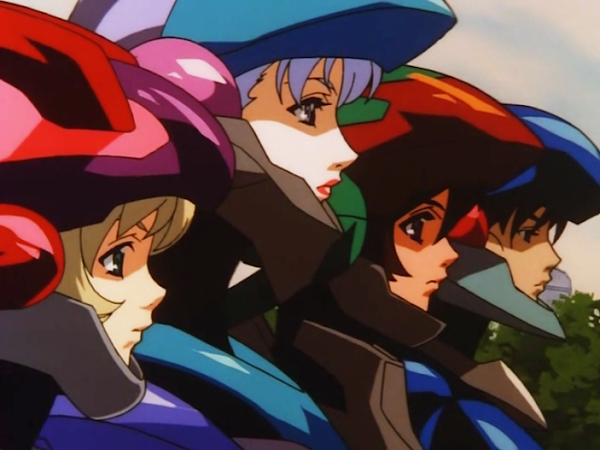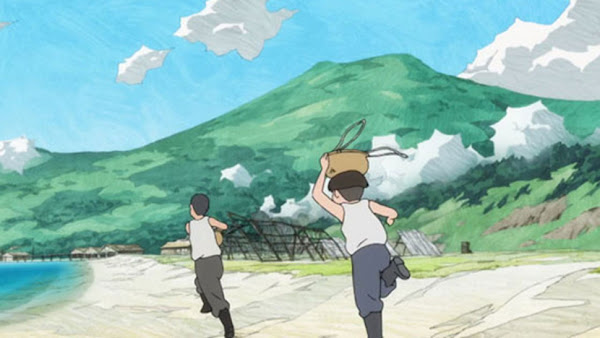Sometimes more is less: Tôkyô 2040
Surprisingly, I actually didn’t hate Bubblegum Crisis: Tôkyô 2040 as much as I thought I would. The trick is being in the right mindset, because if you go into Tôkyô 2040 expecting the same vibes as you got from Bubblegum Crisis, then yes—you are going to be disappointed. Because even though it is a hard reboot of Bubblegum Crisis, even though it has the same protagonists, the same supporting cast, the same villains, the same setting, the same factions and tensions – Bubblegum Crisis and Tôkyô 2040 are incredibly different.
To start with, let me clarify: Bubblegum Crisis is vastly superior to Tôkyô 2040 on the merits. Both of them are superlatively ambitious projects that try to do too much, but even where BGC fails to pull through, it still comes off as having more of a heart. BGC is a fun, campy, kitschy, exuberant, 80s hair-rock mess going in each and every possible different direction. That’s largely a function of the hugely diverse writing and directorial team working within the same concept, and the massive amount of sheer design effort that went into each and every one of the OVAs. There is much more emphasis on atmosphere, æsthetics and attitude in the original OVA series. The massive world-building efforts and the SFnal questions they explore are largely driven by focussing not so much on the Knight Sabres themselves as on the relationships they develop in the world of Mega-Tôkyô that they inhabit.
This gives BGC an opportunity to drop commentary on all sorts of contemporary issues, often surprisingly from a far-left anti-corporatist and anti-imperialist point of view. It’s not that Priss, Celia, Linna and Nene in Bubblegum Crisis don’t have character – they do! – but character development for the Sabres is not a primary priority of the OVA series. Likewise, the storytelling logic of the OVA series, even though there’s a definite continuity to it, is very much episodic. The Knight Sabres’ adventures don’t really have an endgame (even though Ôbari Masami tried to make one for them).
Tôkyô 2040 is very different. Its ambitions are equally stellar, but these ambitions have a much more focussed aim and therefore the flaws can be more glaring. Tôkyô 2040 aims to start from the BGC template and to use it to tell a single coherent story over the course of its 26-episode run. It tries to flesh out the way the four Knight Sabres come to work together. Tôkyô 2040 zooms in more on the romantic relationships and team dynamics of the four ladies, as well as their relationship to the hardsuit technology that they use.
There is a certain degree of charm to this. It gives us an origin story for Linna; it lets us watch the relationship of grudging trust and admiration between Priss and Leon unfold; it lets us explore Celia’s tormented psyche and the unresolved issues she has with her departed father; it lets us see the impact it had on Mackie and how he came to depend on Nene. It also explores the tortured relationship between Celia and the technology that went into the Boomers, giving the series an artificial antagonist far more intimate to Celia than Mason was or could be. All four of the Sabres, as well as their love interests, are given distinct and relatable personalities, which is great to see. But the real question is: what does Tôkyô 2040 sacrifice in order to get this story arc told? As it turns out, the series does sacrifice quite a bit to get there, of what made the original Bubblegum Crisis so fun.
First of all, Tôkyô 2040 is a ‘slow burn’. There is a massive secret to Celia’s (and Mackie’s) existence and her father’s experiments that the Knight Sabres are involved in trying to uncover before Genom does. The pacing with which this secret is gradually unfolded takes place over two thirds of the series run. The show goes into much more detail about how Boomers work, what Boomers are, why they go mad, and how they can be destroyed. Intriguingly, Boomers in Tôkyô 2040 act a lot less like the T-800 in The Terminator and a lot more like the T-1000 in Terminator 2 or, well, the Thing in John Carpenter’s The Thing… ultimately awakened Boomers become something like a liquid memory metal that can take any shape or penetrate and manipulate any kind of technology, and which are driven to imitate non-human organic forms.
There’s accordingly lot more of the technology-driven and cybernetic body horror in Tôkyô 2040 than there is in the original BGC, and a central character who comes close to a kind of deification, which reminds one somewhat of Akira. The alienation from humans and nightmarish apocalyptic robotic takeover of Tôkyô recalls both ‘Construction Cancellation Order’ from Meikyû Monogatari and the ‘Chicken Man and Redneck’ sketch in Robot Carnival… but stretched out over 26 episodes, the series lays it all on a bit thick and drags it out a bit too long. The Boomer takeover of the AD Police, with Nene singlehandedly trying to stop it without her hard suit – a one-episode bit in the original OVA – is dragged out over four episodes in Tôkyô 2040; and what’s more the stakes never feel as high, because the Tôkyô 2040 Boomers suffer from Voyager Borg syndrome.
Second, even though certain motifs of AI transcendence and godhead are touched on and talked about during the entire last half of the show, these motifs don’t really go anywhere and don’t really explore the ramifications in SFnal terms. This is rather frustrating, because – unlike the Sabres themselves, and despite a couple of establishing flashbacks thrown in toward the end – the characters who pose these questions don’t really have an inner life that we get to see or empathise with, and because they don’t really earn their weight. The reflections on religion and technology between Mason and Galatea are anodyne and sterile, and the quasi-New Age panentheism that the show seems to espouse at the end is bland and at the same time appallingly pretentious. I couldn’t help thinking: Tôkyô 2040’s writing staff chucked all of the original BGC’s nascent anti-imperialist, China-sympathetic, pro-Third World political radicalism… for this?
Third: the show wants to be a more serious, darker and grittier reboot of BGC. That means, for the late 90s, getting rid of a lot of the campy 1980s AOR numbers and replacing them in Priss’s (voiced by Asakawa Yû this time) repertoire with more grunge and alternative rock… and less of it. (Despite the fact that all of the episodes are named after song or album titles by Deep Purple, Uriah Heep, Jimi Hendrix, Queen, Led Zeppelin, Yes and so on, there’s lamentably little classic rock used in the actual soundtrack.) It also means using edgier designs for the Boomers in particular. However, it didn’t mean turning down the fanservice, particularly toward the end when the team gets their Mark II hardsuits, which they have to get into naked and which use liquid metal for a form-fitting torso section on each of the Knight Sabres. And it also didn’t mean exploring the same sorts of gritty, near-realistic social SFnal questions that the original BGC and Files do. In fact, the apocalyptic setting got rid of a lot of that concern with social questions, and replaced it with survival-of-humanity themes. The character designs have all been updated to a 90s standard from an 80s one. The differences in the hairstyles of the four Sabres are of course the easiest to notice, and particularly how Nene went from a redhead to a platinum blonde, or how Celia went from having a short black bob to long silvery-blue locks. The bold, straight solid inkwork and the differences in the skin tones (particularly noticeable when Priss and Linna are standing next to each other) are also a noticeable difference between BGC and Tôkyô 2040. I found this change a bit disconcerting at first, but the art style does grow on you if you let it.
So, no, it isn’t the original BGC OVA. And it will be a major letdown if you’re expecting it to be the same in terms of tone or style. On account of this, as well as on account of the ending, I tend to consider it a lesser work than BGC, Files or even Parasite Dolls (which is dark-and-gritty technoir done right). I may have spent several paragraphs harping on its flaws, but despite all of them, Tôkyô 2040 still manages to be entertaining and engaging. It’s worth a check-out, at least for the first few episodes.








Comments
Post a Comment